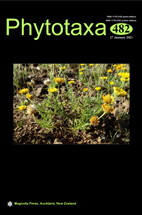Abstract
A new species, Rhexocercosporidium camporesii was collected from dead branches of Scabiosa maritima (Caprifoliaceae) in Forlì-Cesena, Italy. The new species is characterized by a lack of setae surrounding the apothecia and by fusiform, aseptate ascospores containing multiple guttules. Rhexocercosporidium camporesii has larger asci and ascospores than other species of Rhexocercosporidium. Phylogenetic analyses using a combined gene analysis of LSU and ITS sequence data indicated that the new species belongs to Ploettnerulaceae (Helotiales). A detailed morphological description and illustration of the new species are provided.

